05投资
- 格式:doc
- 大小:471.59 KB
- 文档页数:42
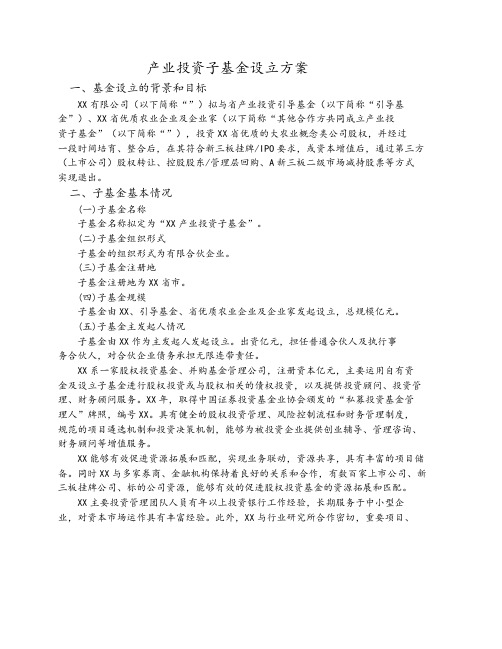
产业投资子基金设立方案一、基金设立的背景和目标XX有限公司(以下简称“”)拟与省产业投资引导基金(以下简称“引导基金”)、XX省优质农业企业及企业家(以下简称“其他合作方共同成立产业投资子基金”(以下简称“”),投资XX省优质的大农业概念类公司股权,并经过一段时间培育、整合后,在其符合新三板挂牌/IPO要求,或资本增值后,通过第三方(上市公司)股权转让、控股股东/管理层回购、A新三板二级市场减持股票等方式实现退出。
二、子基金基本情况(一)子基金名称子基金名称拟定为“XX产业投资子基金”。
(二)子基金组织形式子基金的组织形式为有限合伙企业。
(三)子基金注册地子基金注册地为XX省市。
(四)子基金规模子基金由XX、引导基金、省优质农业企业及企业家发起设立,总规模亿元。
(五)子基金主发起人情况子基金由XX作为主发起人发起设立。
出资亿元,担任普通合伙人及执行事务合伙人,对合伙企业债务承担无限连带责任。
XX系一家股权投资基金、并购基金管理公司,注册资本亿元,主要运用自有资金及设立子基金进行股权投资或与股权相关的债权投资,以及提供投资顾问、投资管理、财务顾问服务。
XX年,取得中国证券投资基金业协会颁发的“私募投资基金管理人”牌照,编号XX。
具有健全的股权投资管理、风险控制流程和财务管理制度,规范的项目遴选机制和投资决策机制,能够为被投资企业提供创业辅导、管理咨询、财务顾问等增值服务。
XX能够有效促进资源拓展和匹配,实现业务联动,资源共享,具有丰富的项目储备。
同时XX与多家券商、金融机构保持着良好的关系和合作,有数百家上市公司、新三板挂牌公司、标的公司资源,能够有效的促进股权投资基金的资源拓展和匹配。
XX主要投资管理团队人员有年以上投资银行工作经验,长期服务于中小型企业,对资本市场运作具有丰富经验。
此外,XX与行业研究所合作密切,重要项目、重点行业向研究员征求意见,共同尽调;还长期外聘相关各行业的专家作为长期顾问。
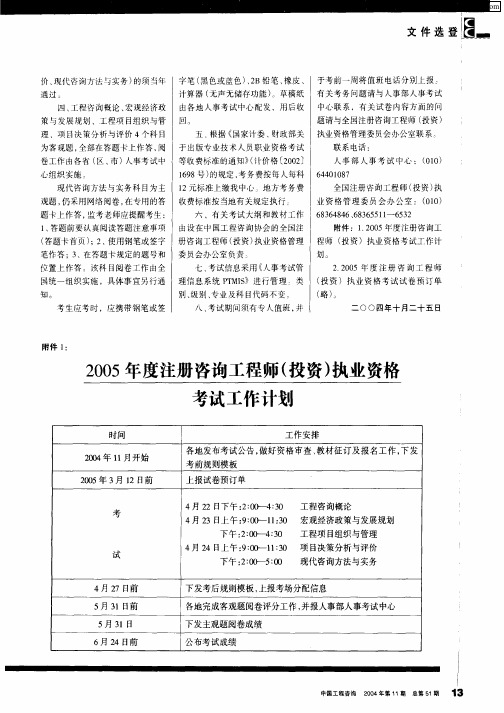
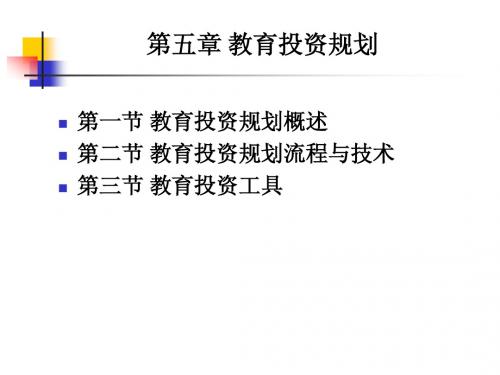
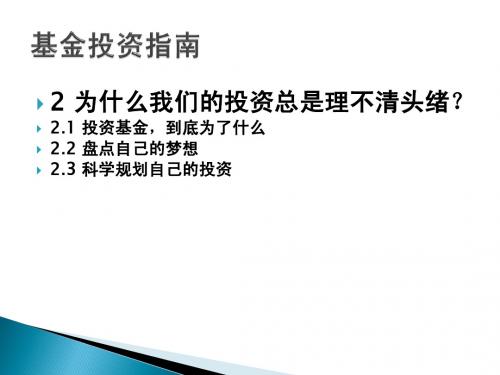

长期股权投资初始计量——非同一控制形成长期股权投资(二)非同一控制下企业合并长期股权投资核算1.非同一控制下企业合并(购并)的基本含义M集团公司C子公司购买方参与合并的各方在合并前后不受同一方或相同的多方最终控制被购买方N集团公司D公司E子公司F子公司合并(二)非同一控制下企业合并长期股权投资核算 2.长期股权投资初始投资成本的确认长期股权投资◆应当以确定的合并成本作为长期股权投资的初始投资成本。
(购买方为取得对被购买方的控制权而支付的现金、非现金资产等的公允价值)购买方支付的相关费用(审计、评估、法律等费用)计入管理费用取得权益与合并对价差额根据具体情况分别处理。
实际支付的价款或对价中含有已宣告但尚未领取的现金股利或利应润,作为应收项目单独入账。
(见账户设置)长期股权投资3.账户设置长期股权投资—成本初始投资成本 处置时的支付的现金等 成本等(合并对价)占被投资方权益数额与合并对价的差额银行存款××××××原材料××××××被合并方所有者权益账面价值× 合并方所占权益比例-合并对价投出的为原材料等存货固定(无形)资产××××××长期股权投资主营业务收入××××××营业外收入×××营业外支出×××投资收益××××××所占权益高于对价投出的为设备等固定资产所占权益低于对价所占权益高于对价投出的为另一项长期投资所占权益低于对价[案例1]华联购并非同一控制的D公司。
协议约定华联公司以银行存款和无形资产作为合并对价,取得D公司70%的股权。
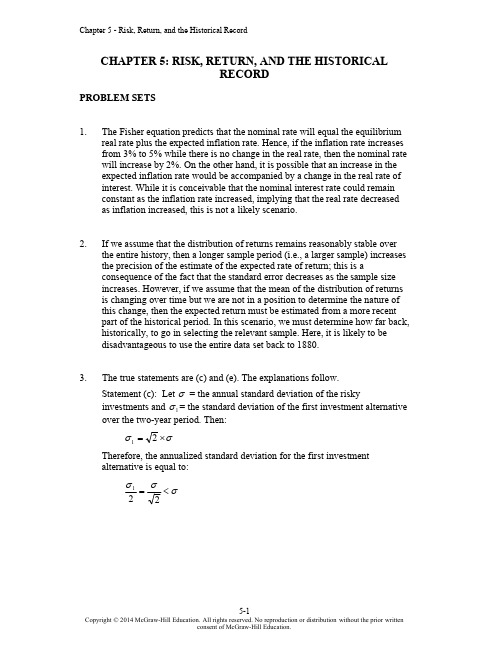
CHAPTER 5: RISK, RETURN, AND THE HISTORICALRECORDPROBLEM SETS1.The Fisher equation predicts that the nominal rate will equal the equilibriumreal rate plus the expected inflation rate. Hence, if the inflation rate increasesfrom 3% to 5% while there is no change in the real rate, then the nominal ratewill increase by 2%. On the other hand, it is possible that an increase in theexpected inflation rate would be accompanied by a change in the real rate ofinterest. While it is conceivable that the nominal interest rate could remainconstant as the inflation rate increased, implying that the real rate decreasedas inflation increased, this is not a likely scenario.2.If we assume that the distribution of returns remains reasonably stable overthe entire history, then a longer sample period (i.e., a larger sample) increasesthe precision of the estimate of the expected rate of return; this is aconsequence of the fact that the standard error decreases as the sample sizeincreases. However, if we assume that the mean of the distribution of returnsis changing over time but we are not in a position to determine the nature ofthis change, then the expected return must be estimated from a more recentpart of the historical period. In this scenario, we must determine how far back,historically, to go in selecting the relevant sample. Here, it is likely to bedisadvantageous to use the entire data set back to 1880.3.The true statements are (c) and (e). The explanations follow.Statement (c): Let = the annual standard deviation of the riskyσinvestments and = the standard deviation of the first investment alternative1σover the two-year period. Then:σσ⨯=21Therefore, the annualized standard deviation for the first investment alternative is equal to:σσσ<=221Statement (e): The first investment alternative is more attractive to investors with lower degrees of risk aversion. The first alternative (entailing a sequence of two identically distributed and uncorrelated risky investments) is riskierthan the second alternative (the risky investment followed by a risk-freeinvestment). Therefore, the first alternative is more attractive to investorswith lower degrees of risk aversion. Notice, however, that if you mistakenly believed that time diversification can reduce the total risk of a sequence ofrisky investments, you would have been tempted to conclude that the firstalternative is less risky and therefore more attractive to more risk-averseinvestors. This is clearly not the case; the two-year standard deviation of the first alternative is greater than the two-year standard deviation of the second alternative.4.For the money market fund, your holding-period return for the next yeardepends on the level of 30-day interest rates each month when the fund rolls over maturing securities. The one-year savings deposit offers a 7.5% holding period return for the year. If you forecast that the rate on money marketinstruments will increase significantly above the current 6% yield, then themoney market fund might result in a higher HPR than the savings deposit.The 20-year Treasury bond offers a yield to maturity of 9% per year, which is 150 basis points higher than the rate on the one-year savings deposit;however, you could earn a one-year HPR much less than 7.5% on the bond if long-term interest rates increase during the year. If Treasury bond yields rise above 9%, then the price of the bond will fall, and the resulting capital losswill wipe out some or all of the 9% return you would have earned if bondyields had remained unchanged over the course of the year.5. a.If businesses reduce their capital spending, then they are likely todecrease their demand for funds. This will shift the demand curve inFigure 5.1 to the left and reduce the equilibrium real rate of interest.b.Increased household saving will shift the supply of funds curve to theright and cause real interest rates to fall.c.Open market purchases of U.S. Treasury securities by the FederalReserve Board are equivalent to an increase in the supply of funds (ashift of the supply curve to the right). The FED buys treasuries withcash from its own account or it issues certificates which trade likecash. As a result, there is an increase in the money supply, and theequilibrium real rate of interest will fall.6. a.The “Inflation-Plus” CD is the safer investment because it guarantees thepurchasing power of the investment. Using the approximation that the realrate equals the nominal rate minus the inflation rate, the CD provides a realrate of 1.5% regardless of the inflation rate.b.The expected return depends on the expected rate of inflation over the nextyear. If the expected rate of inflation is less than 3.5% then the conventionalCD offers a higher real return than the inflation-plus CD; if the expected rateof inflation is greater than 3.5%, then the opposite is true.c.If you expect the rate of inflation to be 3% over the next year, then theconventional CD offers you an expected real rate of return of 2%, which is0.5% higher than the real rate on the inflation-protected CD. But unless youknow that inflation will be 3% with certainty, the conventional CD is alsoriskier. The question of which is the better investment then depends on yourattitude towards risk versus return. You might choose to diversify and investpart of your funds in each.d.No. We cannot assume that the entire difference between the risk-freenominal rate (on conventional CDs) of 5% and the real risk-free rate (oninflation-protected CDs) of 1.5% is the expected rate of inflation. Part of thedifference is probably a risk premium associated with the uncertaintysurrounding the real rate of return on the conventional CDs. This impliesthat the expected rate of inflation is less than 3.5% per year.7.E(r) = [0.35 × 44.5%] + [0.30 × 14.0%] + [0.35 × (–16.5%)] = 14%σ2 = [0.35 × (44.5 – 14)2] + [0.30 × (14 – 14)2] + [0.35 × (–16.5 – 14)2] = 651.175σ = 25.52%The mean is unchanged, but the standard deviation has increased, as theprobabilities of the high and low returns have increased.8.Probability distribution of price and one-year holding period return for a 30-year U.S. Treasury bond (which will have 29 years to maturity at year-end):Economy Probability YTM Price CapitalGainCouponInterest HPRBoom0.2011.0%$ 74.05-$25.95$8.00-17.95% Normal growth0.508.0100.00 0.008.008.00 Recession0.307.0112.2812.288.0020.289.E(q) = (0 × 0.25) + (1 × 0.25) + (2 × 0.50) = 1.25σq = [0.25 × (0 – 1.25)2 + 0.25 × (1 – 1.25)2 + 0.50 × (2 – 1.25)2]1/2 = 0.8292 10.(a) With probability 0.9544, the value of a normally distributedvariable will fall within 2 standard deviations of the mean; that is,between –40% and 80%. Simply add and subtract 2 standarddeviations to and from the mean.11.From Table 5.4, the average risk premium for the period 7/1926-9/2012 was:12.34% per year.Adding 12.34% to the 3% risk-free interest rate, the expected annual HPR for the Big/Value portfolio is: 3.00% + 12.34% = 15.34%.12.(01/1928-06/1970)Small BigLow2High Low2HighAverage 1.03% 1.21% 1.46%0.78%0.88% 1.18%SD8.55%8.47%10.35% 5.89% 6.91%9.11%Skew 1.6704 1.6673 2.30640.0067 1.6251 1.6348Kurtosis13.150513.528417.2137 6.256416.230513.6729(07/1970-12/2012)Small BigLow2High Low2HighAverage0.91% 1.33% 1.46%0.93% 1.02% 1.13%SD7.00% 5.49% 5.66% 4.81% 4.50% 4.78%Skew-0.3278-0.5135-0.4323-0.3136-0.3508-0.4954Kurtosis 1.7962 3.1917 3.8320 1.8516 2.0756 2.8629No. The distributions from (01/1928–06/1970) and (07/1970–12/2012) periods have distinct characteristics due to systematic shocks to the economy and subsequent government intervention. While the returns from the two periods do not differ greatly, their respective distributions tell a different story. The standard deviation for all six portfolios is larger in the first period. Skew is also positive, but negative in the second, showing a greater likelihood of higher-than-normal returns in the right tail. Kurtosis is also markedly larger in the first period.13.a%88.5,0588.070.170.080.01111or i i rn i rn rr =-=+-=-++=b.rr ≈ rn - i = 80% - 70% = 10%Clearly, the approximation gives a real HPR that is too high.14.From Table 5.2, the average real rate on T-bills has been 0.52%.a.T-bills: 0.52% real rate + 3% inflation = 3.52%b.Expected return on Big/Value:3.52% T-bill rate + 12.34% historical risk premium = 15.86%c.The risk premium on stocks remains unchanged. A premium, thedifference between two rates, is a real value, unaffected by inflation.15.Real interest rates are expected to rise. The investment activity will shiftthe demand for funds curve (in Figure 5.1) to the right. Therefore theequilibrium real interest rate will increase.16. a.Probability distribution of the HPR on the stock market and put:STOCKPUT State of the Economy Probability Ending Price +Dividend HPREnding Value HPR Excellent 0.25$ 131.0031.00%$ 0.00-100%Good 0.45 114.0014.00$ 0.00-100Poor 0.25 93.25−6.75$ 20.2568.75Crash0.05 48.00-52.00$ 64.00433.33Remember that the cost of the index fund is $100 per share, and the costof the put option is $12.b.The cost of one share of the index fund plus a put option is $112. Theprobability distribution of the HPR on the portfolio is:State of the Economy Probability Ending Price +Put +Dividend HPRExcellent 0.25$ 131.0017.0%= (131 - 112)/112Good 0.45 114.00 1.8= (114 - 112)/112Poor 0.25 113.50 1.3= (113.50 - 112)/112Crash0.05 112.000.0= (112 - 112)/112c.Buying the put option guarantees the investor a minimum HPR of 0.0%regardless of what happens to the stock's price. Thus, it offers insuranceagainst a price decline.17.The probability distribution of the dollar return on CD plus call option is:State of theEconomyProbability Ending Value of CD Ending Value of Call Combined Value Excellent0.25$ 114.00$16.50$130.50Good0.45 114.00 0.00114.00Poor0.25 114.00 0.00114.00Crash 0.05 114.00 0.00114.0018.a.Total return of the bond is (100/84.49)-1 = 0.1836. With t = 10, the annual rate on the real bond is (1 + EAR) = = 1.69%.1.18361/10 b.With a per quarter yield of 2%, the annual yield is = 1.0824, or8.24%. The equivalent continuously compounding (cc) rate is ln(1+.0824) =.0792, or 7.92%. The risk-free rate is 3.55% with a cc rate of ln(1+.0355) =.0349, or 3.49%. The cc risk premium will equal .0792 - .0349 = .0443, or4.433%.c.The appropriate formula is , σ2(effective )= e2 × m (cc ) ×[e σ2(cc )‒1]where . Using solver or goal seek, setting thetarget cell to the known effective cc rate by changing the unknown variance(cc) rate, the equivalent standard deviation (cc) is 18.03% (excel mayyield slightly different solutions).d.The expected value of the excess return will grow by 120 months (12months over a 10-year horizon). Therefore the excess return will be 120 × 4.433% = 531.9%. The expected SD grows by the square root of timeresulting in 18.03% × = 197.5%. The resulting Sharpe ratio is120531.9/197.5 = 2.6929. Normsdist (-2.6929) = .0035, or a .35% probabilityof shortfall over a 10-year horizon.CFA PROBLEMS1.The expected dollar return on the investment in equities is $18,000 (0.6 × $50,000 + 0.4× −$30,000) compared to the $5,000 expected return for T-bills. Therefore, theexpected risk premium is $13,000.2.E(r) = [0.2 × (−25%)] + [0.3 × 10%] + [0.5 × 24%] =10%3.E(r X) = [0.2 × (−20%)] + [0.5 × 18%] + [0.3 × 50%] =20%E(r Y) = [0.2 × (−15%)] + [0.5 × 20%] + [0.3 × 10%] =10%4.σX2 = [0.2 × (– 20 – 20)2] + [0.5 × (18 – 20)2] + [0.3 × (50 – 20)2] = 592σX = 24.33%σY2 = [0.2 × (– 15 – 10)2] + [0.5 × (20 – 10)2] + [0.3 × (10 – 10)2] = 175σY = 13.23%5.E(r) = (0.9 × 20%) + (0.1 × 10%) =19% $1,900 in returns6.The probability that the economy will be neutral is 0.50, or 50%. Given aneutral economy, the stock will experience poor performance 30% of thetime. The probability of both poor stock performance and a neutral economy is therefore:0.30 × 0.50 = 0.15 = 15%7.E(r) = (0.1 × 15%) + (0.6 × 13%) + (0.3 × 7%) = 11.4%。
第五章长期股权投资习题一、单项选择题1.下列长期股权投资应该采用成本法核算的有( )。
A.对被投资企业实施控制B.对被投资企业不具有重大影响C.对被投资企业具有共同控制或重大影响D.对被投资企业不具有共同控制2.甲企业2007年1月1日对乙企业初始投资成本为165万元,占乙企业资本30%,采用权益法核算。
当年乙企业实现净利润150万元,2008年乙企业发生净亏损750万元,假定甲公司存在长期应收乙公司款项20万元,则2008年末甲企业正确的会计处理方法是( )。
A.借:投资收益 225贷:长期股权投资——损益调整 210长期应收款 15B.借:投资收益 225贷:长期股权投资——损益调整210预计负债 15C.借:投资收益 210贷:长期股权投资—损益调整 165+45=210D.借:投资收益 225贷:长期股权投资——损益调整223.对被投资单位不具有控制、共同控制或重大影响,且在活跃市场中没有报价、公允价值不能可靠计量的权益性投资,应作为( )。
A.长期股权投资B.交易性金融资产C.可供出售金融资产D.持有至到期投资4.企业取得长期股权投资,实际支付的价款或对价中包含的已宣告但尚未发放的现金股利或利润,应计入( )。
A.投资收益B.财务费用C.应收股利D.长期股权投资5.采用成本法核算长期股权投资的情况下,被投资企业发生亏损时,投资企业应当( )。
A.借记“投资收益”科目B.借记“资本公积”科目C.贷记“长期股权投资”科目D.不作处理6.A公司于2007年1月1日用货币资金从证券市场上购入B公司发行在外股份的25%,实际支付价款500万元,另支付相关税费5万元。
同日,B公司可辨认净资产的公允价值为2200万元。
A公司2007年1月1日取得的长期股权投资的初始投资成本为( )万元。
A.550 B.505 C.500 D.5557.A公司于2007年1月1日用货币资金从证券市场上购入B公司发行在外股份的25%,实际支付价款500万元,另支付相关税费5万元,同日,B公司可辨认净资产的公允价值为2200万元,所有者权益总额为2100万元。
长期股权投资的初始计量——同一控制长期股权投资的初始计量长期股权投资同一控制下企业合并与非同一控制下企业合并M集团公司N集团公司D子公司E子公司F子公司合并A子公司B子公司合并C子公司同一控制下企业合并非同一控制下企业合并(一)同一控制下企业合并的长期股权投资核算长期股权投资1.同一控制下企业合并的基本含义M集团公司合并A子公司B子公司C子公司合并方参与合并的企业在合并前后均受同一方或相同的多方最终控制且该控制并非暂时性的,为同一控制下的企业合并。
被合并方(一)同一控制下企业合并的长期股权投资核算长期股权投资2.长期股权投资初始投资成本的确认◆应在合并日按照取得被合并方所有者权益账面价值的份额作为初始投资成本。
◆初始投资成本与支付的现金及转让的非现金资产的账面价值之间的差额,调整资本公积;资本公积不足冲减的,调整留存收益。
◆合并方为进行企业合并发生的各项直接相关费用(审计费用、评估费用、法律服务费用等)计入当期损益。
以上内容结合“账户设置”理解!(一)同一控制下企业合并的长期股权投资核算长期股权投资3.账户设置长期股权投资—成 本初始投资成本 处置时成支付的现金等 本(合并对价)占被投资方权益数额与合并对价的差额银行存款××××××无形资产××××××资本公积××××××被合并方所有者权益账面价值 × 合并方所占权益比例-合并对价所占权益高于对价所占权益低于对价盈余公积××××××资本公积不足时冲减盈余公积等留存收益资产类账户[案例1]华联公司与同一母公司所控制的黄河公司合并。
约定华联公司以银行存款和无形资产作为合并对价,投出银行存款1200万元;无形资产账面价值为420万元。
第五章投资本章主要内容●投资的概念及分类●交易性金融资产的核算●交易性金融资产的期末计价●可供出售金融资产的核算●持有至到期投资的核算●长期股权投资的核算第一节投资的概念及分类●一、投资的概念●投资的概念有广义和狭义之分。
财务会计中的投资通常采用的是狭义的投资概念。
●投资是指企业为通过分配来增加财富,或为谋求其他利益而将资产让渡给其他单位所获得的另一项资产。
●二、投资的分类● 1.交易性金融资产;● 2.可供出售金融资产;● 3.持有至到期投资;● 4.长期股权投资。
第二节交易性金融资产一、交易性金融资产的概念●交易性金融资产是指企业持有的以公允价值计量且其变动计入当期损益的金融资产,包括为交易目的所持有的债券投资、股票投资、基金投资、权证投资等和直接指定为以公允价值计量且其变动计入当期损益的金融资产。
满足下列条件之一的金融资产应当划分为交易性金融资产:● 1.取得该金融资产的目的,主要是为了近期内出售。
例如企业从二级市场购入的股票、债券和基金等;● 2.属于进行集中管理的或辨认金融工具组合的一部分,且有客观证据表明企业近期采用短期获利方式对该组合进行管理。
● 3.属于衍生工具。
二、账户设置●“交易性金融资产”账户核算企业持有的以公允价值计量且其变动计入当期损益的金融资产,包括为交易目的所持有的债券投资、股票投资、基金投资、权证投资等和直接指定为以公允价值计量且其变动计入当期损益的金融资产。
●该账户应当按照交易性金融资产的类别和品种,分别“成本”、“公允价值变动”进行明细核算。
●该账户期末借方余额,反映企业交易性金融资产的公允价值。
三、取得交易性金融资产:●企业取得交易性金融资产,按其公允价值,借记本科目(成本),按发生的交易费用,借记“投资收益”科目,按已到付息期但尚未领取的利息或已宣告但尚未发放的现金股利,借记“应收利息”或“应收股利”科目,按实际支付的金额,贷记“银行存款”等科目。
●取得时:●借:交易性金融资产——成本(公允价值)●投资收益(交易费用)●应收股利(已宣告但未发放的现金股利)●应收利息(已到付息期但尚未领取的利息)●贷:银行存款(或其他货币资金)●例1:某企业于2000年4月4日以银行存款购入A公司股票10000股确认为交易性金融资产,每股成交价12元。
另按成交金额的7.5‰支付佣金、税金等相关费用900元。
会计分录为:●借:交易性金融资产——成本 120000●投资收益 900●贷:银行存款 120900●例2:某企业于2000年7月3日用已存入证券公司的现金购入B公司股票2000股确认为交易性金融资产,每股成交价24元。
其中,0.50元(不含税,有关纳税的会计处理略,下同)为已宣告但尚未分派的现金股利,除权日为7月6日。
另按成交金额的7.5‰支付佣金、税金等相关费用360元。
会计分录为:●借:交易性金融资产——成本 47000●投资收益 360●应收股利——B公司 1000●贷:其他货币资金 48360●例3:某企业于2000年3月1日以银行存款购入C公司发行的到期一次还本付息债券确认为交易性金融资产,该债券面值总额为30000元,五年期,年利率8%。
购入时该债券已发行2年,应计利息4800元,成交价格为34700元,另支付佣金等相关费用130元。
会计分录为:●借:交易性金融资产——成本 34700●投资收益 130●贷:银行存款 34830●例4:某企业于2000年7月3日以银行存款购入D公司1999年7月1日发行的分期付息债券确认为交易性金融资产,该债券面值总额为150000元,年利率8%,每半年付息一次,到期一次还本,成交价格为156000元。
其中包括已到期尚未领取的利息6000元。
另支付佣金等相关费用468元。
会计分录为:●借:交易性金融资产——成本 150000●投资收益 468●应收利息——D公司 6000●贷:银行存款 156468四、现金股利和利息●交易性金融资产持有期间被投资单位宣告发放的现金股利,或在资产负债表日按分期付息、一次还本债券投资的票面利率计算的利息时:●借:应收股利(或应收利息)●贷:投资收益●收到现金股利等时:●借:银行存款(或其他货币资金)●贷:应收股利(或应收利息)●例5:根据前例1,A公司于2000年5月5日宣告于6月8日发放股利,每10股派3股股票股利,每股派0.10元现金股利。
某企业应作如下会计分录:●借:应收股利——A公司 1000●贷:投资收益 1000●某企业于2000年6月8日收到A公司发放的现金股利时,会计分录为:●借:银行存款 1000●贷:应收股利——A公司 1000●对A公司宣告分派的股票股利,某企业不作会计分录,只作备查登记,登记增加A公司股票3000股,由股票股利所得。
●例6:根据前例4,某企业于2000年7月10日领取D公司已到期债券利息6000元,存入银行。
会计分录为:●借:银行存款 6000●贷:应收利息——D公司 6000五、交易性金融资产的期末计价●(一)期末计价的方法●交易性金融资产的期末计价,是指期末交易性金融资产在资产负债表上反映的价值,也是指期末交易性金融资产的账面价值。
按国际惯例,交易性金融资产的期末计价方法有以下三种:● 1.成本法●成本法是指交易性金融资产按投资成本入账后直到处置前,无论市价如何变动,均不调整短期投资账面价值的方法。
● 2.成本与市价孰低法●成本与市价孰低法是指每一会计期末将交易性金融资产的成本与市价进行比较,将价值较低者作为交易性金融资产的期末账面价值并在资产负债表上列示的计价方法。
●《企业会计制度》规定:持有的短期投资,在期末或者至少在年度终了时应以成本与市价孰低计价,并将市价低于成本的金额确认为当期投资损失。
已确认跌价损失的短期投资的价值又得以恢复,应在原已确认投资损失的金额内转回。
● 3.市价法●即按公允价值计价的方法。
●(二)会计处理●交易性金融资产在资产负债表日,交易性金融资产的公允价值高于其账面余额的差额,●借:交易性金融资产——公允价值变动●贷:公允价值变动损益●公允价值低于其账面余额的差额,做相反的会计分录。
●例7:某企业“交易性金融资产——成本A”账户的余额为119900元,“交易性金融资产——公允价值变动A”账户贷方余额为9000元,期末该企业所持A公司股票的市价为110000元,该企业应作会计分录如下:●借:公允价值变动损益 900●贷:交易性金融资产——公允价值变动 900●如期末A公司股票市价为130000元,则:●借:交易性金融资产——公允价值变动19100●贷:公允价值变动损益 19100五、交易性金融资产的处置●出售交易性金融资产时:●借:银行存款等(实际收到的金额)●投资收益(差额)●贷:交易性金额资产(账面余额)●投资收益(差额)●同时,将原计入该金融资产的公允价值变动转出:●借(或贷):公允价值变动损益●贷(或借)投资收益例:(注会教材2009)2007年1月1日A公司从二级市场支付价款1 020 000元(含已到付息期但尚未领取的利息20 000元)购入B公司发行的债券,另发生交易费用20 000元。
该债券面值1 000 000元,剩余期限为2年,票面年利率为4%,每半年付息一次,A公司将其划分为交易性金融资产。
A公司会计处理如下:●借:交易性金融资产——成本 1 000 000●应收利息 20 000●投资收益 20 000●贷:银行存款 1 040 000●2007年1月5日,收到该债券2006年下半年利息:●借:银行存款 20 000●贷:应收利息 20 000●2007年6月30日,该债券的公允价值为1 150 000元(不含利息)。
●借:交易性金融资产——公允价值变动 150 000●贷:公允价值变动损益 150 000●借:应收利息 20 000●贷:投资收益 20 000●2007年7月5日,收到该债券2007年上半年利息。
●借:银行存款 20 000●贷:应收利息 20 000●2007年12月31日,该债券公允价值为1 100 000元(不含利息)。
●借:公允价值变动损益 50 000●贷:交易性金融资产——公允价值变动 50 000●借:应收利息 20 000●贷:投资收益 20 000●2008年1月5日,收到该债券2007年下半年利息。
●借:银行存款 20 000●贷:应收利息 20 000●2008年3月31日,A公司将该债券出售,取得价款1 180 000元(含1季度利息10 000元)。
●借:银行存款 1 180 000●公允价值变动损益 100 000●贷:交易性金融资产——成本 1 000 000●——公允价值变动 100 000●投资收益 180 000●例:某股份有限公司在2007年6月10日以每股15元的价格(其中包含已宣告但尚未发放的现金股利0.2元)购进A股票20万股确认为交易性金融资产,另支付相关税费1.2万元,6月15日收到宣告发放的现金股利,6月20日以每股13元的价格又购进该股票10万股,支付相关税费0.6万元,6月30日该股票价格下跌至每股12元;9月20日以每股16元的价格将该股票18万股出售,支付相关税费1万元,2007年12月31日该股票收盘价为17元。
●2007年6月10日以每股15元的价格(其中包含已宣告但尚未发放的现金股利0.2元)购进A股票20万股确认为交易性金融资产,另支付相关税费1.2万元时:●借:交易性金融资产——成本 296●应收股利 4●投资收益 1.2●贷:银行存款 301.2●6月15日收到宣告发放的现金股利时:●借:银行存款 4●贷:应收股利 4●6月20日以每股13元的又购进该股票10万股,支付相关税费0.6万元时:●借:交易性金融资产——成本 130●投资收益 0.6●贷:银行存款 130.6●6月30日该股票价格下跌至每股12元时:●借:公允价值变动损益(296+130-12×30)66●贷:交易性金融资产——公允价值变动 66●9月20日以每股16元的价格将该股票18万股出售,支付相关税费1万元时:●借:银行存款 287●交易性金融资产——公允价值变动 39.6●贷:交易性金融资产——成本 255.6●投资收益 71●其中:39.6=66×18/30●借:投资收益 39.6●贷:公允价值变动损益 39.6●2007年12月31日该股票收盘价为17元。
●借:交易性金融资产——公允价值变动60●贷:公允价值变动损益 60●其中:60=33.6+66-39.6●或公允价值=17×12=204即账面价值●成本=296+130-255.6=170.4●公允价值变动余额=贷66-39.6=贷26.4●60=204-170.4+26.4●交易性金融资产——公允价值变动=33.6●全年投资收益=-1.2-0.6+71-39.6=29.6●全年公允价值变动损益=-66+39.6+60=33.6●对损益的总体影响=29.6+33.6=63.2●例:2007年5月,A公司以480万元购入B公司股票60万股,作为交易性金融资产,另支付相关税费10万元。